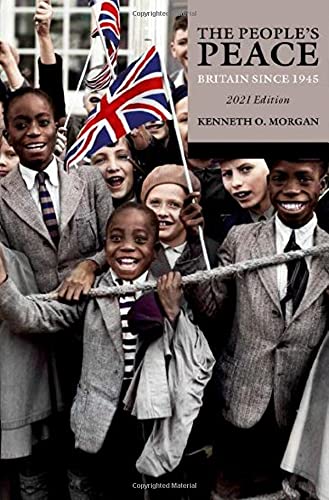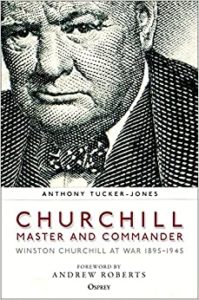
Finest Hour 195
Books, Arts, & Curiosities – The Road from 1945

November 23, 2022
Finest Hour 195, First Quarter 2022
Page 48
Review by Richard Toye
Kenneth O. Morgan, The People’s Peace, 3rd ed., Oxford, 2021, 832 pages, £16.99. ISBN 978–0198841074
Richard Toye is Professor of History at the University of Exeter and author, most recently, of Winston Churchill: A Life in the News (2020).
Kenneth O. Morgan, now Baron Morgan of Aberdyfi, is the most distinguished living historian of British politics and a member of the International Churchill Society’s Board of Academic Advisers. His biography of Keir Hardie appeared back in 1963. His other books include several on Lloyd George and his era and a ground-breaking study of the Attlee government. The People’s Peace first appeared in 1990 and has since been updated periodically. As a primer on post-war politics it is invaluable for the uninitiated, and even experts may be surprised at some of the details, as well as stimulated by the analysis.
The concept of a People’s Peace has complex history. It is, of course, the obverse of the idea of a People’s War. Since the eighteenth century, various of Britain’s wars have been labelled as such. The phrase was generally used to suggest that the people supported the conflict in question, but in the era of total war it took on a new connotation: that the people—including civilians—had a stake in the battle because they were directly involved. This type of language could be found across the political spectrum. Winston Churchill did not use the phrase “People’s War” during the Second World War, but he came close. In a speech of 14 July 1940, which was received with great enthusiasm, he stated, “This is no war of chieftains or of princes, of dynasties or national ambition; it is a war of peoples and of causes.” He celebrated the “Unknown Warriors,” the ordinary citizens whose individual contributions would never be recorded.

2025 International Churchill Conference
Yet in spite of his impressive personal popularity, over the next five years Churchill failed to turn such rhetoric to electoral account. Morgan suggests that the “kind of unity that Churchill embodied… was traditional and highly limited.” He actually had a strong past record on social reform, but he saw discussion of reconstruction as a distraction from winning the war. The 1942 Beveridge Report on social services received wide acclaim, but Churchill’s attitude appeared grudging and even hostile. His belated attempts to catch up with the mass mood failed to convince enough voters that he would be an effective post-war leader.
By the time that Churchill’s coalition broke up, it was Labour that monopolised the idea of the People’s Peace. The party offered a list of specific policies, which it went on to put into effect, but the electorate was probably captured by a generalised sense of hope rather than by enthusiasm for, say, the nationalisation of the Bank of England. Morgan emphasises the low-key and somewhat conventional disposition of Attlee and many of his colleagues: “Amidst the very euphoria of victory in 1945, the nation offered not a triumph of the will but a suspicion of change and the paralysis of self-doubt.”
In spite of the limitations of its vision, Labour achieved remarkable constructive change during its six years in power. As Morgan shows, when Churchill returned to Downing Street in 1951, he was careful not to do anything that might jeopardise the seemingly fragile support enjoyed by the Tories. This meant maintaining industrial peace, if necessary through generous government-brokered wage settlements. The Prime Minister “was above all anxious to demonstrate his capacity for ordered, peaceful statesmanship, carrying the working-class with him in patriotic endeavour, and to refute early accusations that he was an unreconciled class warrior.” That Churchill was now in his late seventies, and in declining health, meant that his main interest and activity was focused on the international scene.
Yet the problems of the 1950s cannot all be laid at the feet of Winston Churchill. Britain’s dramatic loss of great power status was disguised, for a time, by rising domestic affluence. But in the early 1960s, persistent balance of payments crises were one factor that triggered fears of “decline” and much handwringing about the seeming sclerosis of British industry. Morgan’s account of the Wilson and Heath years makes for depressing reading. But the book is not all high politics. Morgan is engaging on many aspects of culture, seems sceptical about the rise of “permissiveness,” and is an enthusiast for women’s equality.
Margaret Thatcher was both a feminine icon and an anti-feminist. Morgan demonstrates a (fairly heavily) qualified admiration and highlights the realities behind the myth. The Iron Lady “was one whose reputation was in reality based on dialogue rather than sabre-rattling.” When she started believing her own propaganda, she set the scene for her own downfall. The Major interregnum further discredited the Conservative brand, to the benefit of Tony Blair’s New Labour. Morgan concludes that “A People’s Peace, tentatively launched in 1945, might finally have taken root.” But it was not to last.
The final chapters, written for this masterly new edition, cover the period from 2001 to the outbreak of the Covid pandemic. In spite of the Global Financial Crisis and the travails of Brexit, Morgan sees some grounds for optimism. Still, he takes a fairly negative view of the current level of British political leadership. “In the Churchill-Attlee period during and after the war, the British knew and respected those by whom they were led,” he writes. Morgan is surely correct to believe that standards have declined in this respect, which is not to say that we should romanticise the past. As this superb book illustrates, Britain’s post-1945 history has many dark aspects as well as positive ones. The twists and turns of the story of the Peace reflect, in part, a long-standing set of arguments about who “The People” actually were.
Subscribe
WANT MORE?
Get the Churchill Bulletin delivered to your inbox once a month.





